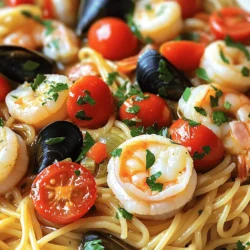If you crave a delicious seafood pasta dish that’s both simple and flavorful, you’re in the right place! I’ll guide you through each step to create a meal that impresses. From selecting fresh seafood to perfecting pasta, my tips ensure you’ll avoid common pitfalls. With several variations and storage tips, this dish will become a staple in your kitchen. Let’s dive into the best seafood pasta recipe that everyone will love!
Ingredients
Essential Ingredients for Seafood Pasta
To make a great seafood pasta, you need some key items. Here’s what you need:
– 8 oz spaghetti or linguine
– 1 tablespoon olive oil
– 3 cloves garlic, minced
– 1 small onion, finely chopped
– 1/2 teaspoon red pepper flakes (adjust to taste)
– 1 cup cherry tomatoes, halved
– 1 cup shrimp, peeled and deveined
– 1 cup scallops, cleaned
– 1 cup mussels, cleaned and debearded
– 1 cup vegetable broth
– 1 tablespoon lemon juice
– Fresh parsley, chopped (for garnish)
– Salt and pepper to taste
– Grated Parmesan cheese (optional)
These ingredients create a dish that bursts with flavor. The seafood brings a fresh taste, while garlic and onion add depth.
Optional Ingredients for Enhanced Flavor
You can add more flavors if you want. Here are some ideas:
– A splash of white wine for acidity
– Chopped fresh basil for a herbal note
– Zucchini or bell peppers for extra veggies
– A pinch of saffron for a rich color and taste
These extras can take your seafood pasta to the next level. Feel free to mix and match based on your taste.
Tips for Selecting Fresh Seafood
Choosing fresh seafood is important for the best flavor. Here are some tips:
– Look for clear eyes: Fresh fish should have bright, clear eyes.
– Check the smell: Fresh seafood should not smell too fishy. A light ocean scent is good.
– Feel for firmness: The flesh should be firm to the touch. If it feels mushy, it’s not fresh.
– Ask your fishmonger: Don’t hesitate to ask for advice on what is fresh that day.
When you choose fresh seafood, your pasta will taste much better. Always look for quality to impress your guests.
Step-by-Step Instructions
Cooking the Pasta to Perfection
First, boil water in a large pot. Add salt to the water; it should taste like the sea. Next, add 8 ounces of spaghetti or linguine. Cook according to the package directions until it is al dente. This means it should be firm but not hard. Drain the pasta, but save some of the water. Set the pasta aside while you prepare the sauce.
Sautéing Aromatics for Depth of Flavor
In a big skillet, heat 1 tablespoon of olive oil over medium heat. Once the oil is hot, add 3 minced garlic cloves and 1 finely chopped small onion. Stir them together and cook for about 3 to 4 minutes. The onion should become soft and clear. This step adds a tasty base to your dish. After the onion is ready, add 1 cup of halved cherry tomatoes and 1/2 teaspoon of red pepper flakes. Cook this mixture for an extra 2 to 3 minutes. The tomatoes should soften and smell great.
Preparing the Seafood Mixture
Now it’s time to add the seafood. Add 1 cup of shrimp, 1 cup of scallops, and 1 cup of mussels to the skillet. Pour in 1 cup of vegetable broth and cover the skillet. Let it simmer for 5 to 7 minutes. You’ll know it’s done when the mussels open and the shrimp turns pink. After that, take off the lid and add the cooked pasta. Toss everything together well. If it seems dry, add a splash of the pasta water you saved. Finish it off by stirring in 1 tablespoon of lemon juice and seasoning with salt and pepper. This is where the dish becomes bright and fresh.
Tips & Tricks
How to Achieve the Best Texture and Flavor
To get great texture and flavor, cook pasta just right. Aim for “al dente,” which means it should be firm but not hard. This helps the pasta hold its shape and adds a nice bite. Use plenty of salt in your pasta water. It makes a big difference! When you add the seafood, don’t overcook it. Shrimp should turn pink, and scallops should be opaque. Mussels need to open up. This ensures they stay tender and juicy.
Common Mistakes to Avoid When Making Seafood Pasta
One mistake is cooking seafood too long. Overcooked seafood gets tough and chewy. Another mistake is not seasoning properly. Always taste your dish before serving. Adding salt, lemon, or herbs can really boost the flavor. Avoid using frozen seafood if you can. Fresh seafood tastes best and enhances the dish. Finally, don’t skip the pasta water. It helps bind the sauce and pasta together.
Suggested Cooking Tools for an Easy Experience
Having the right tools can make cooking easy. Here’s what I recommend:
– A large pot for boiling pasta
– A colander for draining
– A large skillet for sautéing
– A wooden spoon for mixing
– A zester for lemon juice
– A sharp knife for chopping
– A cutting board for prep
These tools will help you create your Ocean’s Bounty Seafood Pasta with ease. Get ready to impress with this simple and flavorful dish!

Variations
Classic Ingredients Swaps
You can change a few ingredients to make this dish your own. Instead of spaghetti, you can use fettuccine or penne. They work well, too. If you want more veggies, add spinach or bell peppers. Swap the cherry tomatoes for sun-dried tomatoes for a richer flavor. To give it a different taste, use white wine instead of vegetable broth. These small swaps can make a big difference.
Adding Different Seafood: Alternatives to Consider
Feel free to mix up the seafood! If you can’t find mussels, try clams or even squid. You might love using crab meat or lobster for an extra touch of luxury. For a heartier taste, add some smoked salmon. Each type of seafood offers a unique flavor. This keeps your dish exciting and fresh every time you make it.
Vegetarian or Vegan Seafood Pasta Options
You can create a plant-based version of this dish. Use mushrooms to mimic the texture of seafood. Portobello mushrooms work well in this case. You can also use tofu or tempeh for added protein. For a seafood-like flavor, try seaweed or kelp. These options give you the taste of the ocean without using any seafood. Plus, they keep the dish light and healthy.
Storage Info
How to Store Leftover Seafood Pasta
To store leftover seafood pasta, first let it cool. Place it in an airtight container. Make sure to cover it well. This will keep it fresh for up to three days. Always refrigerate it promptly to avoid spoilage.
Best Practices for Reheating
When you reheat seafood pasta, do it slowly. Use a skillet over low heat. Add a splash of water or broth to keep it moist. Stir often to heat evenly. You can also use the microwave. Heat it in short bursts, stirring in between. This way, it warms up without drying out.
Freezing Tips for Meal Prep
If you want to freeze seafood pasta, use freezer-safe containers. Leave some space at the top, as it will expand. It can last up to two months in the freezer. To enjoy it later, thaw it in the fridge overnight. Reheat it as described for best results. For a quick meal, consider freezing in single portions. This makes for easy, delicious dinners later!
FAQs
What is the best type of seafood for pasta dishes?
The best seafood for pasta includes shrimp, scallops, and mussels. These options bring great flavor and texture. You can also use clams, crab, or squid for variety. I love mixing seafood depending on what I find fresh at the market.
Can I use dried pasta instead of fresh?
Yes, dried pasta works well in seafood dishes. It has a nice bite and can hold sauce better. Just cook it al dente as instructed on the package. This way, it will not get mushy when you mix it with the seafood.
How to make a creamy sauce for seafood pasta?
To create a creamy sauce, start with heavy cream or a mix of cream and broth. Add garlic and onion for flavor. You can also stir in some grated cheese, like Parmesan, for richness. Mix this with your seafood and pasta for a delicious dish.
What can I serve with seafood pasta?
Seafood pasta pairs well with a crisp salad or garlic bread. A light green salad adds freshness. Garlic bread brings a nice crunch and complements the dish well. You can also serve it with a glass of white wine for a special touch.
How to make Ocean’s Bounty Seafood Pasta gluten-free?
To make Ocean’s Bounty Seafood Pasta gluten-free, use gluten-free pasta. Many good options are available, like rice or quinoa pasta. Just follow the cooking instructions on the package. Enjoy the same great flavors without gluten!
In this guide, we explored essential ingredients, step-by-step instructions, and helpful tips for making seafood pasta. You learned how to select fresh seafood, cook pasta well, and avoid common mistakes. We discussed variations, storage methods, and answered key questions about seafood pasta.
Remember, the right ingredients and techniques can turn a simple dish into something special. Enjoy your seafood pasta journey!


